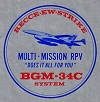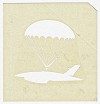




Ray Vitkus worked for Teledyne-Ryan Aeronautical (TRA) during the seventies and eighties, initially as a senior tooling, quality and manufacturing engineer, later as lead engineer on several projects including the Firebee laser target (Model 336 High Altitude Target Skylite) and the Mach 4.3 Firebolt. Ray kindly contributed his photos and information from this time.
The group photo shown below was made at Point Mugu, where TRA conducted most of its test flying with the various Model 147 / AQM-34 versions. The photo was cleared on 10 August 1972, which helps in dating it. The group is surrounded by four AQM-34's:

|

|

|

|

|
The next photo strongly appears to be related to the one on page 107 of 'Lightning Bugs and other reconnaissance drones', since it shares all small details such as the six or seven white dots on the fuselage. It is identified in the book as a Model 147H / AQM-34N. But there are several factors that makes this unlikely. First, there is a battery hatch (on the forward top fuselage, outlined with quick-release fasteners) that the 147H doesn't have (see the USAF Museum's AQM-34N). Second, the 147H doesn't have the 'skid' fairing under the nacelle, but the photo shows clearly shows a faceted curvature of the nacelle's lower side, caused by the fairing. Third, the wingroot fairing on the 147H (and T/TE/TF) is much larger. The 147G photo on page 111 of 'Lightning Bugs' appears to have a battery hatch and identical faceted curvature of the nacelle's lower side.

|
An Air Force CH-3 returns a Firebee after a MARS-recovery to Point Mugu (Navy S-2's are visible on the flightline). The exact version is again difficult to identify. If the wing span is calculated using the tail plan span as a reference, a 27ft wing span results. This would make the Models 147B, E, F, G and J candidates. MARS-recoveries were used operationally starting with the J-model, but the photo could show an older model used for MARS-tests. Five white markings can be seen on the nose, possibly (test) mission markings, or, considering their size, special markings indicating successful MARS recoveries?

|
The Firebee in the next photo appears to be a 32 feet 'big wing' version. Since it has a short dorsal fairing (not extending forward of the pylon) it must be a Model 147H / AQM-34N (see the USAF Museum's AQM-34N for comparison). The photo was again made at Point Mugu, and the Firebee has red or orange extremities as usual for factory test versions. It appears that something has been fitted to the tip of the left horizontal tail (right for the viewer).

|

|
The photo below shows a Model 147NC / AQM-34H at an antenna test range, being prepared for antenna radiation pattern measurements. It is fitted with ALE-2 chaff pods, and possibly these are the reason for the measurements: to verify that these pods did not adversely affect reception/transmission. The nose section is noteworthy: it appears that a Model 147NA (or standard BQM-34) front fuselage is combined with the radome of the 147NC. This creates a noteworthy step in the front fuselage contour. Quite strange, but it probably doesn't affect the measurements.

|
Another interesting photo shows 147SC / AQM-34L SC-126 in the same color scheme as seen in the group photo. The fuselage is painted in three shades of gray, the color of the vertical tail appears to be slightly darker than the darkest fuselage color. The tail cone is black as usual, the horizontal tails are fitted with endplates of the small version. The front fuselage looks quite weathered. The radome is painted or molded in black and white.

|
The Model 147SD / AQM-34M in the photo below appears to have a fin tip with the rear top half cut away. It is an illusion however: the rear half of the Firebee is in the shadow of the DC-130E's wing, but a small part of the fin tip is fully lit, and this has the same gray value as the sky. It is fitted with the small version of the horizontal tail end plates, and lacks the film reel bulges seen on the front fuselage of some AQM-34M's. No markings can be seen on this Firebee, those on the tail blocked from view by the anti-sway brace system used for large-wing Firebees. The photo was made at Edwards, the TRA photo ID is 4-5096, dated 29 August 1972. Possibly the Firebee is SD-2 which was assigned to the 6514th at about this time.

|
The next photo shows a Model 147TE / AQM-34Q on the pylon, during TRA flight testing at Point Mugu. Interestingly it does not have the anti-flutter weight installed at the wing tips. Thirteen mission markings of an unknown design are painted on the front fuselage. They look like horse-collar shaped top half and a darker circular lower half. The left-wing tank appears to have a light gray front section and an red/orange and bare metal rear section. The right-wing tank looks black all over, but a slightly different color photo shows that the front section is gloss red. The avionics hatch appears to be painted red/orange. The streaks on the vertical tail are not explained yet. The carrier is a DC-130E, judging from the drone pylon shape and the pylon tank.

|
A great close-up of Model 147TE / AQM-34Q TE-14 on the pylon of a DC-130E. It is likely being prepared for its 31st mission, since it sports 30 mission marks on the side, the most forward one with the number '30'. The photo appears to have been taken at the same time as the photo on page 171 of 'Lightning Bugs'.

|
Next are a few BGM-34B photos, including the pathfinder version of the BGM-34B. One to two 'hippos' were converted from the batch of eight BGM-34B's built. Related photos can be found in 'Fireflies and other UAVs' on pages 100 and 101. It is being loaded with Mark 81 laser guided bombs fitted with extended (low-speed) MXU-602 wings. The BGM-34B's are light gray overall with 'U.S. AIR FORCE' markings on the fuselage, and the left photo seems to show an identification ending in '4' on the vertical tail. The leading edge of the pylon looks a little different compared to other DC-130 photos. Considering the snow and the weapons, the photo was likely during testing at Hill AFB. According to a SPIE paper, flight testing of this version took place between October 1973 and August 1974, and 22 captive flight and 8 free flight missions were flown.
Three pathfinder systems were delivered by Philco-Ford. Two were designed for day use with a low light level TV (LLLTV) camera (possibly a Fairchild Camera AXQ-2) and Philco-Ford stabilized laser target designator (LTD), and one was for night use with a Hughes Aircraft FLIR (forward looking infra-red) system and the same laser target designator. The LTD or the whole system is quoted to weigh 250 pounds. The system is usually described as similar to the Pave Knife pods, but considering that pod's size and weight (1200 pounds) this is unlikely. The Pave Tack (as used in the F-111F) is equally heavy at 1400 pounds. Pave Spike is much smaller and lighter, but it was built by Westinghouse.

|

|

|
The next photo shows a recce BGM-34C on a ground launch installation. The main key is the temperature probe on the left front fuselage, just above the open hatch, which is unique to the BGM-34C (the only other Firebee version that possibly had a temperature probe on the left side is the Lear Siegler modified YAQM-34U). It is fitted with a recce nose section with a KS-120 camera (identical to that of the 147SD / AQM-34M), which explains the color change. If you look closely, the slightly raised camera windows can be seen. It has endplates (as usual) on the horizontal tails. Based on the color schemes of other BGM-34C's, the center fuselage appears to be painted orange/red on the top side and light gray on the lower side.

|
Ray also provided a few factory cards showing the main characteristics of various TRA products. This Model 147SB is quite unique, since no confirmed SB photos are shown in books or articles. The camouflage is also very interesting, similar to that of SC-126 shown above and to that of the Navy Model 147SK version.

|

|
The card of the Model 259 / BGM-34C shows an artist's impression, with a nose shape, tail antenna and fuel tanks that were different in reality. The card also reveals that Lear Siegler (LSI) electronic components were used.

|
The last Model 259 / BGM-34C item shown here is a brochure or report cover.

|
This great factory photo shows wind tunnel test preparations. The Firebees are Model 147TE or TF's (AQM-34Q or R), judging from the drop tanks and data link antenna on the vertical tail. The Hercules likely represents a DC-130E since it has inboard drop tanks, but the three-bladed props were only used on DC-130A's.

|
Ray found an old recovery decal: a white parachute and Firebee printed on a transparent sticker. This is likely the 'mission marking' seen on many Firebees used operationally in Vietnam. A unique piece! The white printing is 4.1" / 104 mm high.

|
Ray also provided photos of the early TAC Firebees and the Hill AFB AQM-34V's.